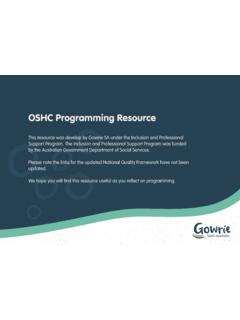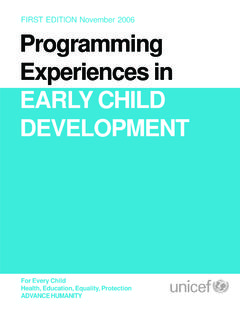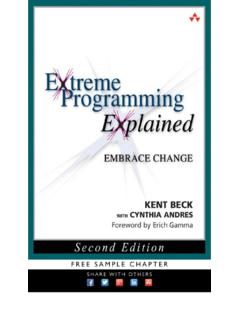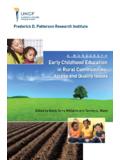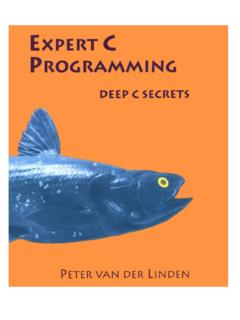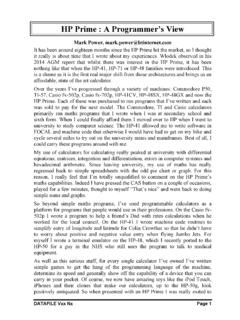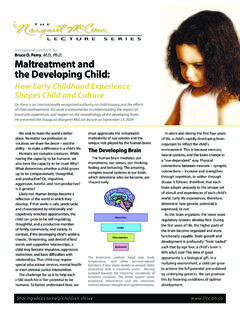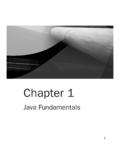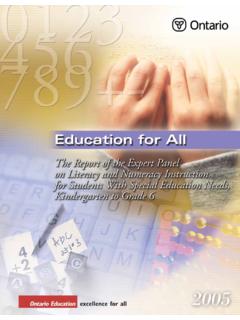Transcription of Early Childhood Program Examples - gowriesa.org.au
1 Early Childhood Program ExamplesIdeas and InspirationGowrieSouth AustraliaWhen developing programs, educators generally consider what s working well and what might need improving to support the most effective and engaging programs for children. Having other programs to look at can offer inspiration and ideas for getting started or to use as a reflection tool for your own programs. As part of this process educators may have questions like What should the Program look like? or Am I doing it right? In this resource, you will find a selection of real Examples of programs that offer ideas and inspiration for possible Program formats to support working with the Early Years Learning Framework (EYLF) and the National Quality Standards (NQS).
2 These programs have been developed over time in response to the introduction of the EYLF and NQS and to fit a particular context. With this in mind, you will need to make sure that ideas you get from these fit your own context and that they are understood and engaged with by educators within your guiding documents in the development and delivery of a Program are: the EYLF, the EYLF Educators Guide, the National Quality Standard, the National Law, and the National South AustraliaPO Box 408, Hindmarsh SA 5007 Phone: 08 8234 5219 Tollfree: 1800 129 606 Email: AustraliaIdeas and inspiration for Program formats for Belonging, Being, Becoming, the Early Years Learning Framework (EYLF)These documents provide information about what is required and who is Early Years Learning Framework guides educators in developing quality programs for children.
3 It describes the Early Childhood pedagogy (principles and practice) and the outcomes required to support and enhance young children s learning from birth to five years of age, including their transition to school. (ACECQA 2011, Guide to the National Quality Standard, )The National Quality Standard, 2011 requires all services to work towards continuous improvement. That means that the Program design as well as its implementation needs to be thought of as an evolving process over time. Standard Educators and co-ordinators are focused, active and reflective in designing and delivering the Program for each child.
4 (ACECQA 2011, Guide to the National Quality Standard, )The educators whose programs are included in this document all talked about different versions of the formats, and that there was still work to be done. When educators are on the lookout for ways to improve Program processes and formats they are engaging in the cycle of continuous improvement and reflective practice. We hope that this resource is the beginning of a networking and sharing portfolio which is designed to be built upon and added to. You can do this in your service by using a folder to include copies of formats from this resource and any others that you develop or borrow from other services.
5 We also hope to develop an online portfolio of programming Examples . You can share your Program formats with us by emailing us at and find out what others are doing via our website developing this resource, we had many conversations and debates about: What do we mean by Program ? What does a Program look like?We suggest this is a really useful place to start. Have conversations at staff or team meetings about your Program . Talk with each other about what you mean when you say the Program . You might also want to talk about what the Program is for and what you want to include in your Program .
6 This is a great time to do some research into the guiding documents to find out what is required. Having this conversation with all educators in your service will prepare you for the assessment visit and support understanding of your programming process. NQS You may need to discuss with the Assessor how your service uses information about children s learning and development based on reflection and documentation to inform and evaluate programs to support children in achieving outcomes. (ACECQA 2011, Guide to the National Quality Standard, )In the development of this resource, we engaged in discussions with a number of educators about their perspectives on What is a Program ?
7 And What is it for? We were amazed at the differing perspectives around these questions. What is a Program ?It s the thing on the wall that tries to communicate to families, educators, and assessors (and anyone else who needs to see it) what we are planning to do or what we have done to support children s SaraA Program is the documentation which is used to make sense of and plan to extend the learning that has been happening with children. The documents are a record of the learning journey and a guide for educators to direct their thinking and enrich the Michelle A Program is a document which helps educators map the journey of the children in their care - both where they ve been and where they are going.
8 It guides the educators, children and families and helps identify goals and Program is a planned approach to implementing the curriculum with children. It is highly contextualised on the individual needs and dynamics of the children, families and educators it is designed for and LyndsayWhatis it for?What could our Program look like?How could we display it?The Planning CycleThis will look different in each service and maybe even within services because the Program reflects the context the children, the families, the educators, the environment, the community, the philosophy. Taking time to explore and understand your context will really help in the development of your Program .
9 Having professional conversations with each other about your philosophy and how it relates to the Program provides a solid foundation to work the following pages we have adapted the planning cycle diagram from the EYLF Educators Guide (DEEWR 2010, ) At each step there are some reflective questions to consider which will help you to reflect individually and/or with other educators and to think about how you make decisions about planning and documentation. As the Early Years Learning Framework suggests, the Program encompasses far more than just a list of planned experiences. So when Program planning, educators need to consider such things as the environment, the routines, the everyday resources, and even the skills and knowledge of the educators who work with the Guide to the National Quality Standard (2011) says: An ongoing cycle of planning, documenting and evaluating children s learning underpins the educational Program and involves educators in critically thinking about what is offered and why.
10 Written plans, records of child assessment and evaluations underpin practice with children and families and enhance the accountability and professionalism of the service (ACECQA 2011, Guide to National Quality Standard, )CONSTRUCT PERSONAL AND SITE PHILOSOPHYPLAN LEARNING EXPERIENCESINDIVIDUAL AND GROUP GOALSENVIRONMENT, EDUCATOR ROLE, ASSESSMENT AND EVALUATION METHODSIMPLEMENT PLANSASSESS ANDEVALUATE TEACHINGAND LEARNINGEARLY YEARS PLANNING CYCLEB elonging, Being and BecomingREFLECT/REVIEWQUESTIONPLANACT / DOAdapted from Early Years Planning Cycle (DEEWR 2010, EYLF Educators Guide, ) How have our conversations with families helped us learn more about each child?
